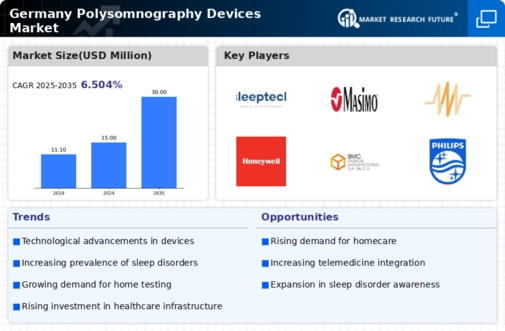Growing Geriatric Population
The aging population in Germany is a significant driver for the polysomnography devices market. As individuals age, the likelihood of developing sleep disorders increases, necessitating effective diagnostic tools. The demographic shift towards an older population is evident, with projections indicating that by 2030, over 25% of the German population will be aged 65 and above. This demographic trend is likely to create a heightened demand for polysomnography devices, as healthcare providers seek to address the unique sleep health needs of older adults. Furthermore, the integration of sleep studies into geriatric care protocols is becoming more common, which may lead to increased utilization of these devices. Consequently, the market is expected to grow at a rate of around 6% annually, driven by the need for tailored sleep solutions for the elderly.
Government Initiatives and Funding
Government initiatives aimed at improving healthcare infrastructure in Germany are playing a crucial role in the polysomnography devices market. Increased funding for sleep disorder research and the promotion of health technologies are encouraging the development and adoption of advanced polysomnography devices. The German government has implemented various programs to enhance diagnostic capabilities in sleep medicine, which includes financial support for healthcare providers to acquire state-of-the-art equipment. This support is expected to lead to a more robust market environment, fostering innovation and accessibility. Additionally, the emphasis on preventive healthcare is likely to drive the integration of polysomnography devices into routine health assessments, further expanding their market presence. As a result, the market could experience a growth trajectory of approximately 7% over the next five years.
Rising Prevalence of Sleep Disorders
The increasing incidence of sleep disorders in Germany is a primary driver for the polysomnography devices market. Conditions such as sleep apnea, insomnia, and restless leg syndrome are becoming more prevalent, affecting a significant portion of the population. Recent studies indicate that approximately 30% of adults in Germany experience some form of sleep disorder, which necessitates effective diagnostic tools. This growing patient base is likely to drive demand for polysomnography devices, as healthcare providers seek to improve diagnosis and treatment options. Furthermore, the rising awareness of the health implications associated with untreated sleep disorders, such as cardiovascular diseases and diabetes, underscores the need for advanced polysomnography devices. As a result, the market is expected to expand, with an estimated growth rate of around 8% annually over the next few years.
Increased Focus on Sleep Health Awareness
The growing emphasis on sleep health awareness in Germany is significantly impacting the polysomnography devices market. Public health campaigns and educational initiatives are raising awareness about the importance of sleep quality and its correlation with overall health. As more individuals recognize the detrimental effects of poor sleep, there is a corresponding increase in the demand for diagnostic tools to assess sleep quality. This trend is likely to lead to a higher adoption rate of polysomnography devices among both healthcare providers and patients. Additionally, the rise of wellness culture, which prioritizes holistic health approaches, is further driving interest in sleep studies. The market could see a growth rate of approximately 5% as awareness campaigns continue to promote the significance of sleep health.
Technological Innovations in Sleep Monitoring
Technological advancements in sleep monitoring are significantly influencing the polysomnography devices market. Innovations such as portable sleep monitors, advanced sensors, and artificial intelligence algorithms are enhancing the accuracy and efficiency of sleep studies. These developments allow for more comprehensive data collection and analysis, which is crucial for diagnosing complex sleep disorders. In Germany, the integration of telemedicine with polysomnography devices is also gaining traction, enabling remote monitoring and consultations. This shift not only improves patient access to care but also reduces the burden on healthcare facilities. The market is projected to witness a surge in demand for these innovative devices, with an expected increase in market value reaching € 500 million by 2027. Such advancements are likely to attract investments and drive competition among manufacturers.





















Leave a Comment